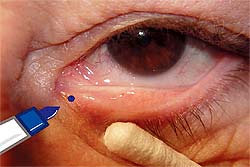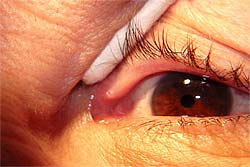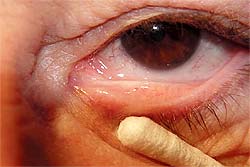Diode laser punctal closure an option for dry eye
Permanent punctal occlusion with a diode laser may be gentler than cautery, more effective than argon, surgeon says.
Click Here to Manage Email Alerts
Permanent punctal closure using a diode laser is an effective option for controlling moderate to severe dry eye in selected patients, according to Charles D. Rice, MD. The risk of irreversible post-laser epiphora seems low, he said, based on a study of 24 patients with a mean follow-up of 15 months.
Dr. Rice said he does not recommend permanent occlusion without first testing the dry eye patient's toleration of punctal plugs.
"Diode laser occlusion is not a primary treatment in most patients, but can be considered as primary treatment without previous punctal plug placement in severe dry eye patients," Dr. Rice said in an interview with Ocular Surgery News.
Current options for punctal occlusion in dry eye patients include the placement of temporary silicone punctal plugs, thermal cautery of one or more puncta, or punctal closure with argon laser. Diode laser closure is an option that avoids some of the drawbacks of these other treatments, Dr. Rice said.
Dr. Rice's study was prompted by the frequent occurrence of displaced punctal plugs.
"Temporary silicone punctal plug placement for dry eye patients has limitations due to the 30% to 50% rate of eventual extrusion and findings of bacterial adherence to the silicone tube, which may induce more inflammatory components in the tear film," Dr. Rice said. "A long-term solution is needed for these patients, rather than repeated punctal plug placement."
Argon laser punctal closure has been reported to have a low success rate (10%), possibly due to the inability to cauterize the canalicular area sufficiently, Dr. Rice said. A smooth occluded surface was the treatment endpoint in argon laser studies rather than destruction of tissue, he said. Thermal cautery has higher reported success rates (70% to 90%), but it is difficult to precisely control the selective cauterization of the canalicular ring. Control of the depth and duration of cauterization and the exact temperature are challenging, he said.
In the diode laser technique, the canalicular area is first stained with gentian violet, promoting absorption of the laser energy, Dr. Rice said.
"The laser energy of the 532-nm wavelength ... is selectively absorbed by the artificial chromophore gentian violet, resulting in more coagulation of tissue with eventual contraction of the punctum," he said. "The magnification through the slit lamp and precision of the laser make this technique desirable."
|
|
|
|
Images: Rice CD |
|
Laser treatment
In his practice, Dr. Rice uses either an Iridex Oculight 532-nm diode laser or a Lumenis Novus Verdi laser, also at 532 nm. In the study described in his poster presentation at the American Society of Ophthalmic Plastic and Reconstructive Surgery meeting, Dr. Rice used the Novus Verdi laser.
"Either laser can be used in punctual closures because they deliver exactly the same wavelength and have the same settings," Dr. Rice said.
The retrospective study included 27 dry eye patients treated from October 2001 through September 2003. All patients had undergone previous placement of punctal plugs in conjunction with maximally tolerated medical therapy, Dr. Rice said. A total of 60 puncta in the 27 patients were treated.
In the laser technique, the medial lower lid margin was infiltrated with local anesthetic, followed by application of gentian violet to the punctal opening. A protective metal corneal shield was placed before the laser light was delivered via a slit-lamp adaptor. A 500-µm spot size with 800 mW of power for 0.2 seconds was used for all patients, Dr. Rice said. The epithelial lining and fibrous canalicular ring were ablated to a 1.5-mm width and a 1-mm depth with between 30 and 50 pulses, Dr. Rice said. Ophthalmic ointment was applied postoperatively for 2 weeks.
"The typical response after laser treatment is complete closure at 2 to 3 weeks with a small pinpoint opening observed at 4 to 5 months, which remains at that diameter," Dr. Rice said.
Of the 27 patients, 24 patients with 54 treated puncta were available for analysis. The interval between punctal plug placement and laser treatment ranged from 2 to 60 months, with a mean of 18 months. Of 54 plugs placed, 30 (55%) spontaneously extruded prior to treatment, Dr. Rice said.
The interval from time of laser treatment to last follow-up exam ranged from 4 to 30 months, with a mean of 15 months, Dr. Rice said.
Success of punctal closure was defined as either complete punctal closure or a pinpoint opening, he said. The success rate was 49 of 54 (90%) with no cases of epiphora following laser punctal closure.
Punctal closure correlated with an improvement in punctate keratopathy and tear film stability as well as lessening of dry eye symptoms, he added.
"Permanent punctal closure with the 532-nm diode laser is a safe and successful adjunct in the management of patients with moderate to severe dry eye disease," Dr. Rice said.
For Your Information:
- Charles D. Rice, MD, can be reached at Lansing Ophthalmology, 2001 Coolidge Road, East Lansing, MI 48823 U.S.A.; +1-517-337-1668; fax: +1-517-337-1779; e-mail: crice@loeye.com. Dr. Rice has no direct financial interest in the products mentioned in this article.
- Kim Norton is an OSN Staff Writer who covers all aspects of ophthalmology.




